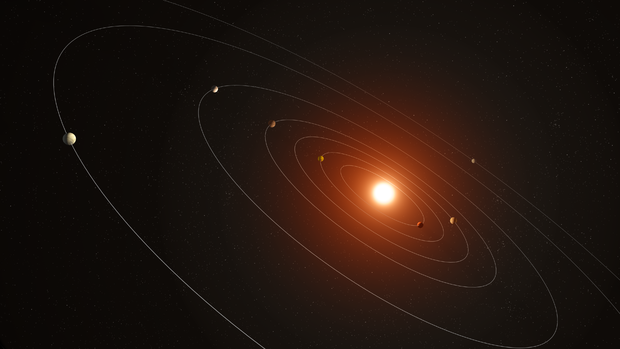NASA telescope reveals 7 new planets orbiting distant star "hotter than the sun"
Astronomers studying data from NASA's retired Kepler space telescope discovered a new system of seven "scorching" planets orbiting a distant star that is bigger and hotter than the sun, the space agency said Thursday.
NASA described the newly found planets as "sweltering" and "bathed" in radiant heat emitted by the host star that was described as "sun-like." That star is 10% larger and 5% "hotter than the sun," NASA said, and there is more heat per area from that star than any planet in our solar system experiences.
All of the planets are larger than Earth, with the two inner planets just slightly larger and the other five planets even bigger, about twice the size of Earth. The inner planets are "probably rocky and may have thin atmospheres," NASA said, while the five outer planets are expected to have thick atmospheres.
The system has been dubbed the Kepler-385 system because of the retired telescope's role in finding the planets.
This system is listed in a new catalog of planet candidates discovered by the telescope. There are almost 4,400 planet candidates in total, including more than 700 multi-planet systems, but NASA said it's rare that there is a system with more than six planet candidates. A planet candidate means that a planet has been discovered by a telescope, but not yet confirmed to actually exist.
NASA said that the catalog focused on "producing a comprehensive list that provides accurate information about each of the systems, making discoveries like Kepler-385 possible."
The Kepler telescope, which was designed to search for planets like those found in the Kepler-385 system, stopped its primary observations in 2013, and conducted an extended mission until 2018. It showed that there are more planets than stars in the galaxy, and helped establish a detailed picture of what each of these planets and their home systems look like.
"We've assembled the most accurate list of Kepler planet candidates and their properties to date," said Jack Lissauer, a research scientist at NASA's Ames Research Center in California's Silicon Valley and lead author on the paper presenting the new catalog. "NASA's Kepler mission has discovered the majority of known exoplanets, and this new catalog will enable astronomers to learn more about their characteristics."





